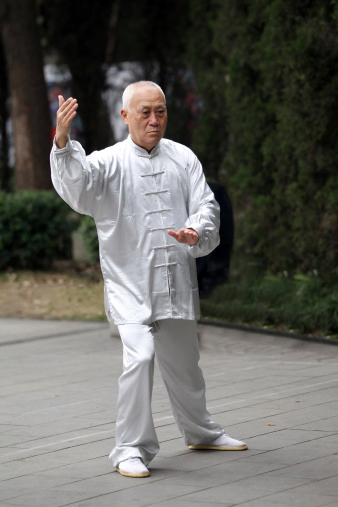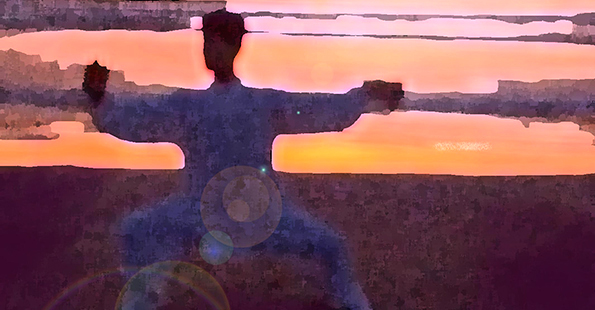Let me return to the words of Master Huang. Normally, when Master Huang used the words, “t’ai chi”, he was referring to our art, t’ai chi ch’uan. In all the time we spent together he never used the full name, “t’ai chi ch’uan”. This is common in the world of Chinese martial arts, where “t’ai chi” is recognized to mean “t’ai chi ch’uan”. At the time when Master Huang made his simple statement, “Everything is t’ai chi.” I assumed he was referring to the martial art that he was teaching me.
As time has passed, however, and as I have gained both wisdom and a broader perspective, I now believe he was, in fact, referring to T’ai Chi. This is why I capitalize “T’ai Chi” in the statement, “Everything is T’ai Chi.” It is also why I differentiate between T’ai Chi in capitals and t’ai chi in lower case using the Wade-Giles spelling. For me, T’ai Chi is, indeed, everything. The martial art of t’ai chi ch’uan, while extremely important in my life, is secondary to the study of T’ai Chi, which is the Tao, or way, of my life.
I realize that it is trite to refer to a single statement or aphorism as “words to live by.” However, I really have found Master Huang’s simple statement, “Everything is T’ai Chi.” to be the catch-phrase of my life, and I have striven to incorporate his words into my daily practice in the years since. This underlying concept has guided my studies in Taoism, t’ai chi ch’uan, and ch’i gung. More importantly, this insight has provided me with a foundation for living my life, observing and respecting nature, and interacting with family, friends, neighbors, co-workers and the people with whom I come into contact on a daily basis.
 Recently I ran across an article posted on the Internet by the renowned Patrick Kelly, a student of the famous Huang Sheng Shyan. In this article, written to commemorate the 100th anniversary of Master Huang’s birth, Patrick Kelly wrote the following:
Recently I ran across an article posted on the Internet by the renowned Patrick Kelly, a student of the famous Huang Sheng Shyan. In this article, written to commemorate the 100th anniversary of Master Huang’s birth, Patrick Kelly wrote the following:
“By the time I came to know Master Huang, inside he was first a Daoist and second a martial artist. Once when sitting outside eating, he looked up at the stars; then, gesturing to the expanse of the night sky, he turned to me and said, ‘That is the big Taiji., inside us is the small Taiji.’ Then after a moment’s pause he added quietly, ‘Now I teach Taiji, not Taijiquan.’”[1]
These words ring as true to me now as my own Master Huang’s words came to mean to me some twenty years ago. It is evident to me that any serious student of Yang style t’ai chi ch’uan must also study the Tao, and in so doing must, by virtue of the sincere practice of this art, reach the obvious conclusion that “Everything is T’ai Chi.”
As Taoists, we must recognize that, ultimately, nature and the cosmos are neither benign nor malignant. The Universe follows a natural order, and that order is governed by T’ai Chi. Studying nature and observing the natural order with an open mind is an excellent way to understand T’ai Chi. Recognizing the influence of T’ai Chi in all natural phenomena enables one to accept with equanimity both good fortune and calamity, abundance and scarcity, youth and old age, living and dying.
The natural world can teach us many of the lessons we need to learn in order to live in harmony and balance. For this reason, it is highly beneficial to live in an environment where nature can be observed on a daily basis. Ideally, one should live in the mountains, by a lake or a river, or by the ocean. The clean air and the influence of water are highly beneficial to our physical, mental, and spiritual well-being.
The opportunities for enjoying nature are plentiful if you are motivated to take advantage of them. Engaging in outdoor activities is both healthful and life-renewing. However, as students of Yang style t’ai chi ch’uan, we should also avail ourselves of the opportunity to observe nature from the perspective of yin and yang, Heaven and Earth, strength and weakness, fullness and waning. Everything in nature teaches us about T’ai Chi. Open your eyes and open your mind. You will see that, truly, “Everything is T’ai Chi.”
Once you perceive that “Everything is Tai Chi.”, you will naturally begin to incorporate the principles of T’ai Chi into your daily t’ai chi ch’uan practice. With this realization, you will find yourself effortlessly seeking a balance between yin and yang, empty and full, advance and retreat, movement and stillness. The ultimate goal of our martial art is the embodiment of the principles of T’ai Chi in our practice. As we practice the form, pushing hands, or standing meditation, we should strive to practice not only t’ai chi ch’uan, but also T’ai Chi, the Supreme Ultimate.
[1] Patrick Kelly, Taiji – Daoist Principles in Practice, http://www.patrickkellytaiji.com/WHOAMII/PK/ENkualalumpurticlepk.htm

Leave a Reply